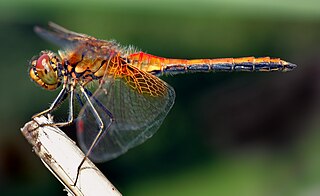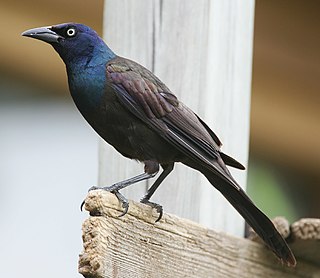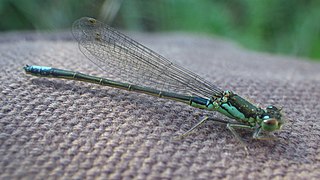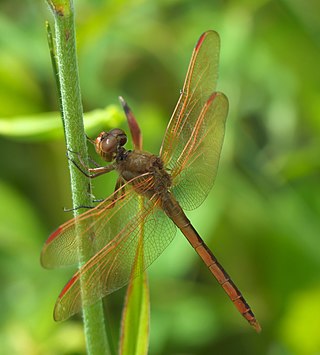
A dragonfly is a flying insect belonging to the infraorder Anisoptera below the order Odonata. About 3,000 extant species of true dragonflies are known. Most are tropical, with fewer species in temperate regions. Loss of wetland habitat threatens dragonfly populations around the world. Adult dragonflies are characterized by a pair of large, multifaceted, compound eyes, two pairs of strong, transparent wings, sometimes with coloured patches, and an elongated body. Many dragonflies have brilliant iridescent or metallic colours produced by structural colouration, making them conspicuous in flight. An adult dragonfly's compound eyes have nearly 24,000 ommatidia each.

The piping plover is a small sand-colored, sparrow-sized shorebird that nests and feeds along coastal sand and gravel beaches in North America. The adult has yellow-orange-red legs, a black band across the forehead from eye to eye, and a black stripe running along the breast line. This chest band is usually thicker in males during the breeding season, and it is the only reliable way to tell the sexes apart. The bird is difficult to see when it is standing still, as it blends well with open, sandy beach habitats. It typically runs in short, quick spurts and then stops.

The black-tailed skimmer is a dragonfly belonging to the family Libellulidae.

The common grackle is a species of large icterid bird found in large numbers through much of North America. First described in 1758 by Carl Linnaeus, the common grackle has three subspecies. Adult common grackles have a long and dark bill, pale yellow eyes, and a long tail. Adults often have an iridescent appearance on their head, especially males. Common grackles can be found widely across North America east of the Rocky Mountains.

The swallow-tailed kite is a pernine raptor which breeds from the southeastern United States to eastern Peru and northern Argentina. It is the only species in the genus Elanoides. Most North and Central American breeders winter in South America where the species is resident year round.

The Hine's emerald is an endangered dragonfly species found in the United States and Canada. Populations exist in Illinois, Michigan, Missouri, Ontario, and Wisconsin. Larvae are found in shallow, flowing water in fens and marshes, and often use crayfish burrows. Major threats to the species include habitat loss and alteration, and the species is legally protected in both the United States and Canada.

The flame skimmer or firecracker skimmer is a common dragonfly of the family Libellulidae, native to western North America.

Pantala flavescens, the globe skimmer, globe wanderer or wandering glider, is a wide-ranging dragonfly of the family Libellulidae. This species and Pantala hymenaea, the "spot-winged glider", are the only members of the genus Pantala. It was first described by Johan Christian Fabricius in 1798. It is considered to be the most widespread dragonfly on the planet with good population on every continent except Antarctica although rare in Europe. Globe skimmers make an annual multigenerational journey of some 18,000 km ; to complete the migration, individual globe skimmers fly more than 6,000 km —one of the farthest known migrations of all insect species.

The widow skimmer is one of the group of dragonflies known as king skimmers. The nymphs live in the water, molting and growing until they are ready to emerge from the water and then molting a final time to reveal their wings.

Ischnura gemina is a species of damselfly in the family Coenagrionidae known by the common name San Francisco forktail. It is endemic to the San Francisco Bay Area in California in the United States. This uncommon insect has a total range of less than 500 square miles in the Bay Area, occurring only in greater San Francisco and parts of San Mateo and Marin Counties. This species is "one of the rarest Odonates in the United States."

Libellula angelina, also known as bekko tombo, is a species of dragonfly in the family Libellulidae, native to China and Japan. It is under threat by rapid loss of the ponds and other small water bodies it uses as habitat, and is currently classified as critically endangered by the IUCN.

Megalagrion leptodemas, commonly referred to as the Crimson Hawaiian damselfly, is one of the rarest and most endangered Megalagrion species that is endemic to the island of Oahu in Hawaii. It is currently labeled as endangered by the ESA and critically endangered on the IUCN Red List. The general biology of Crimson Hawaiian damselflies is similar to other narrow-winged damselflies. Megalagrion leptodemas used to be found in the mountains of Ko’olau and Wai'anae but is now only found in four watersheds in the Ko’olau Mountains. The species is threatened by habitat loss and non-native species. They have limited habitat and small, scattered populations which can affect their future population stability. Conservation efforts for this species should concentrate on both habitat management and control of invasive species.
Schayera baiulus is a species of grasshopper in the family of the Acrididae. The species is endemic to the Northern Region of Tasmania in Australia. The species is extremely rare and critically endangered, with only five confirmed specimens ever found.

The Big Sandy crayfish, Cambarus callainus, are freshwater crustaceans of the family Cambaridae. They are found in the streams and rivers of Appalachia in Virginia, West Virginia, and Kentucky, in what is known as the Big Sandy watershed. Populations are often mistaken with Cambarus veteranus, but morphological and genetic data suggest that these are separate taxa; however, both are protected under the Endangered Species Act. There is very little information available on the Big Sandy crayfish because it is a relatively new species.

The tau emerald is a species of dragonfly in the family Corduliidae. Corduliidae is the only family not a clade within the Infraorder Anisoptera. The species was first described by Edmond de Sélys Longchamps in 1871.

Libellula auripennis, the golden-winged skimmer, is a species of skimmer in the family Libellulidae. It is found in North America.

Libellula nodisticta, the hoary skimmer, is a species of skimmer in the dragonfly family Libellulidae. It is found in Central America, North America, and South America.

Libellula needhami, or Needham's skimmer, is a species of skimmer in the family of dragonflies known as Libellulidae. It is found in the Bahamas, Cuba, Mexico, and the United States.

Libellula composita, the bleached skimmer, is a species of skimmer in the dragonfly family Libellulidae. It is found in North America.

Libellula axilena, the bar-winged skimmer, is a species of skimmer in the dragonfly family Libellulidae. It is found in North America.





















